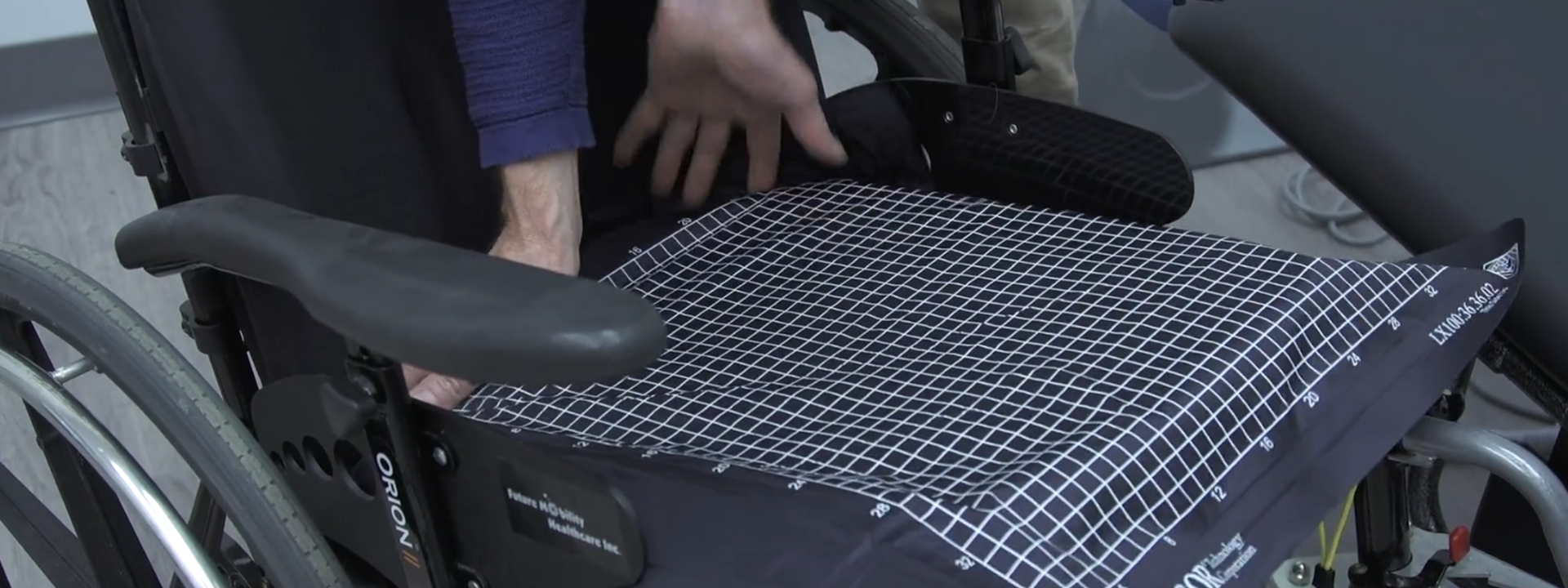
Pressure Mapping for Wheelchairs: Prevent Injuries & Improve Comfort
Understanding Pressure Mapping Technology for Better Wheelchair Seating
Where a patient’s body meets their wheelchair, you want them to experience nothing but safe pressure and support. All too often, however, that area of contact is riddled with sore spots and ongoing injury risk for the person bound to it.
Whether the patient needs a wheelchair only for a few weeks or months or will require it for the rest of their lives, it must be comfortable. The research is clear:
“People living with chronic pain are at heightened risk for mental health problems, including depression, anxiety, and substance use disorders. Chronic pain can affect sleep, increase stress levels and contribute to depression. An estimated 35% to 45% of people with chronic pain experience depression.”
Given those statistics, ensuring safety with the wheelchair seating surface in all sitting positions is necessary. Not only does this prevent pressure injury and skin breakdown, but it also just makes people happier.
How do we accomplish this, exactly?
That’s where mapping technology comes in.
Why Is Pressure Distribution Important?
Before we discuss pressure mapping, though, let’s talk about why pressure distribution is so important.
People may find themselves confined to wheelchairs for an extended period for many reasons. That could be due to spinal cord injury, another permanent condition, or simply while they heal from a broken leg.
Areas of high pressure against bony protuberances can create problems for wheelchair users. As problem areas intensify over time, they develop sore spots and broken skin, which leads to poorer patient outcomes. These include:
- Discomfort and inability to find a good position;
- Reduced blood flow to the area;
- Pressure sores, or areas that become inflamed and may even break open and suppurate;
- Inflamed pelvis bones, also called ischial tuberosities or sit bones; and
- Difficulty healing these areas due to the need to continue sitting in the wheelchair.
Any of these problems can make sitting time unpleasant or even unbearable for patients. To prevent this, it’s important to alternate cushions where necessary to mitigate areas of higher pressure. More important, though, is to get the right fit between the patient and chair cushions in the first place.
To accomplish both of these, you need a means of obtaining accurate pressure readings, which means you must understand how pressure mapping for wheelchair seating works.
Pressure Mapping for Wheelchairs
Wheelchair users often develop pressure injuries because high-pressure areas form between their bony prominences—typically their sit bones—and their seating surface. Many patients cannot identify where these pressure points occur or how intense they are, making prevention difficult. Pressure mapping technology addresses this challenge by using a network of sensors that measure contact pressure across the entire seating surface.
These sensors generate detailed pressure readings that create color-coded visualizations, with high-pressure areas displayed in red and orange, and low-pressure areas in green and blue. This precise visual feedback clearly identifies problem areas, allowing for targeted adjustments to the wheelchair and cushions.
By providing both visual representations and thousands of data points showing exactly where pressure concentrates, these mapping systems enable occupational therapists and medical professionals to make evidence-based seating modifications. Healthcare providers can then educate wheelchair users on optimal positioning techniques and movement strategies to redistribute pressure, significantly reducing discomfort and the risk of pressure injuries.
How Does the Pressure Mapping for Wheelchairs Work?
All right, you’re sold on the power of pressure mapping to increase patient safety and comfort and to minimize the burden of guesswork for occupational therapists, doctors, nurses and other caretakers. But how exactly does such a system work, and how can you implement it at your clinic or care facility?
Here’s the basic rundown:
Purchase a Wheelchair Cushion Pressure Mapping System
Systems like ForeSite® SS give you all the tools to take accurate pressure readings and put them into practice. You can build accurate pressure maps in minutes by combining sensor-based hardware with software that captures wireless data.
Take Pressure Readings
Lay the mat over the wheelchair cushion and measure the points of contact between the person and the actual chair they will use.
However, any readings can help determine whether exactly the bony protuberances are in your patient’s body and correct them.
Use Data & Mapping for Complete Visualization
The software system will build a complete pressure map, showing exactly where pressure occurs in colour-coded imaging equivalent to that you’d see with a brain scan: areas of high activity (pressure) in warm colours and low activity (pressure) in blue.
This is especially useful because it allows the patient to chime in with their experience about where tissue breakdown occurs. Working with them, you can devise a wheelchair cushioning solution – that may or may not include flotation – to minimize their discomfort.
Adjust as Necessary
Sometimes a patient’s situation changes. They may heal, for instance, meaning they are spending less time in the chair. Or they may have a degenerative condition that means they lose muscle mass and ability over time, creating different pressure areas.
Either way, you can take a new pressure reading and teach the patient to adjust accordingly. This greatly benefits both patient and caregiver, because the former remains safe while the latter has to do less guessing.
The Ultimate Wheelchair Pressure Imaging System for Therapists & Clinicians
The XSENSOR ForeSite® SS is the ultimate pressure imaging system for therapists and clinicians. Now you can help prevent pressure injuries in patients using wheelchairs without a bunch of recalibration and with the utmost confidence in your results. Provide pressure relief the first time, and continue providing it for your patients over the long haul.
Would you like to learn more about pressure mapping software here at XSENSOR? We invite you to get in touch for a demo, to ask questions or to learn more about our systems today.

